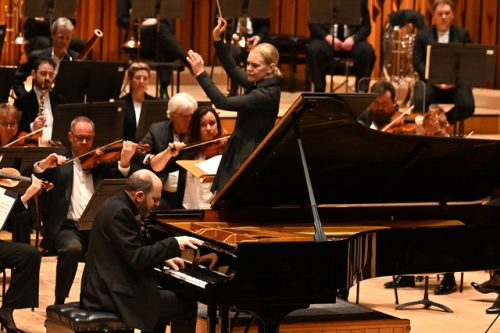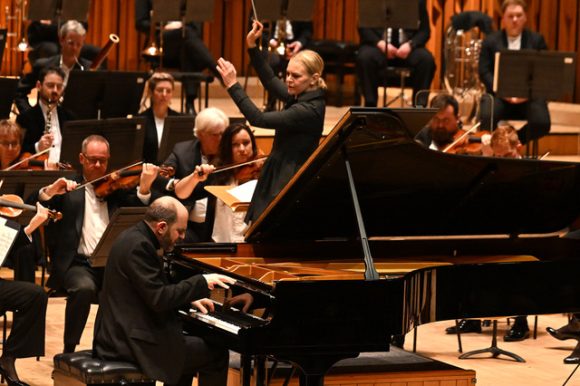 United Kingdom Benjamin, Hindemith, Rachmaninoff: Kirill Gerstein (piano), London Symphony Orchestra / Susanna Mälkki (conductor). Barbican Hall, London, 30.11.2023. (MBr)
United Kingdom Benjamin, Hindemith, Rachmaninoff: Kirill Gerstein (piano), London Symphony Orchestra / Susanna Mälkki (conductor). Barbican Hall, London, 30.11.2023. (MBr)

Benjamin – Concerto for Orchestra
Hindemith – Symphony: Mathis der Maler
Rachmaninoff – Piano Concerto No.3
Some concerts have no discernible shape to them – and this was one of those. It is certainly not unusual to program a concerto in the second half – particularly when it’s a work as large as Rachmaninoff’s Third Piano Concerto – but the sneaky suspicion this wasn’t to lead to some desertion of the ranks should the program have been reversed did pass through my mind.
Neither George Benjamin’s Concerto for Orchestra nor Paul Hindemith’s Symphony: Mathis der Maler sat quite comfortably together in the first half, and especially placed in the order they were. The Hindemith, championed early on by Herbert von Karajan in his Berlin years – then swiftly dropped, much as he would do later with Rimsky-Korsakov’s Scheherazade – came second and could, I think, have been interpreted two ways in this performance by Susanna Mälkki and the London Symphony Orchestra: strikingly beautiful, or jaw-droppingly dull.
Mathis der Maler grapples for its inspiration from a triptych of paintings – the Isenheim Altarpiece – by Matthias Grünewald. But it also has much more than what we see. Hindemith only gives us some of the altarpiece; the weaker performances of this work do much the same. The ‘Concert of Angels’ is in part a nativity and Hindemith richly scores the music for it – and that came through in Mälkki’s exquisite handling of the orchestral textures. But this is all angelic when Grünewald actually hints at something more malevolent. There is little room for Hindemith to diverge in the ‘Entombment’ – the music is every bit as poignant and glorious as the moment itself. Mälkki at least made something of the trumpets here, turning them into a choir of lamentation which felt musically right.
The problem, I think, came in the final movement – ‘The Temptation of St Anthony’. There was a disconnect here, the performance missing the mark in giving us a vision of St Anthony’s torments at Satan’s creatures sent to torture him. True, Hindemith is never quite as skilful or visual in his orchestration as Bartók was in The Miraculous Mandarin (think of the terrifying ‘The mandarin catches up with the girl after an ever wilder chase’) but Mälkki could have made more of St Anthony’s gruelling suffering: this is someone being beaten, clawed and savaged and yet the LSO woodwind and strings felt neutered by the event, hardly descending into the chaos and onslaught the altarpiece paints us. Which brings us to what Hindemith doesn’t show us but which the greatest performances of Mathis der Maler have. The Isenheim Altarpiece is about the crucifixion, and it is one of the most horrific there is. Great performances of Mathis der Maler are more vinegary than this one was, they are also just more terrifying, too.
George Benjamin’s Concerto for Orchestra, a commission by the Mahler Chamber Orchestra, is shorter in length than similar works by Bartók and Lutoslawski – and in a single movement where their works are not. Although it doesn’t obviously highlight one instrument over another in one sense it does because Benjamin brings to the fore the tuba, so often overlooked in orchestras and yet given something of a starring role in this work. Like Lutoslawski’s concerto, Benjamin’s details are enormously intricate – the wefts of instrumental colour are cleverly woven together – often an instrument doesn’t work in isolation but in a pair (such as with the clarinets). The strings can be fidgety and run like unruly children around other instruments, but it is in a kind of complexity that is ultra-organised – should the conductor have a baton that is wielded strictly enough. Mälkki proved more than capable of doing that, and the LSO played well for her. But when Hindemith’s Mathis der Maler deals with more celestial and powerful material, and Benjamin’s is a more life-affirming work entirely, the programming seemed a little off balance to me.
I have been living with Rachmaninoff’s Third Piano Concerto almost daily for two years – books come slowly – and performances still surprise me. Program notes sometimes surprise me, too – especially the annotators who suggest performances of this concerto run for 39-minutes. They hardly ever do these days – if they are uncut (which they almost always are) and they use the long cadenza (which they almost usually do). This one, however, played by Kirill Gerstein was pretty spot on. Swift this performance most certainly was.

Performances of this concerto came to a fork in the road in 1958 when Van Cliburn won the Tchaikovsky Competition – and, largely, give or take, pianists have been in either the Rachmaninoff or the Cliburn camps since. Gerstein is absolutely in the former – in fact, I was quite astonished as to how close this performance was to Rachmaninoff’s own in so many ways. The opening to the Allegro ma non tanto was a cracking one – very close to Rachmaninoff’s own, itself a very fast one (more Allegro, less ma non tanto). Also extremely fast was the Allegro at the molto marcato with some thunderous fff pummelling at the Alle breva that came right out of the Rachmaninoff play book. The long cadenza could be seen in two ways, and I tended to skew towards the latter here: as a display of sheer virtuosic playing it was magnificent; from the perspective of dynamic contrast it left much to be desired (but that, too, comes right out of the Rachmaninoff playbook).
Perhaps unsurprisingly the Adagio was on the fleet side but not without a certain intensity. Rachmaninoff scores very low down on the keyboard at times here – notably a low over-hand D-flat that often goes nowhere – and it sounded less deep in Gerstein’s hands than it might have. The Maestoso, too, once such a hand grenade for Russian pianists (Vladimir Ashkenazy was explosive here, even if he often wasn’t elsewhere) was a departure from Rachmaninoff but the final movement, the Alla breve had Gerstein back on course. He was perhaps finer here than in the previous movements melding considerably more poetry than he managed in the Intermezzo with a brilliance that never quite sounded gruesomely over the top. Perhaps most surprising was the Meno mosso (the most often cut section from this movement, as the composer had done). He applied more rubato than I imagined he would and it sounded magnificent. Likewise, the beauty of the playing up to the first of the cadenzas was crystalline; if Gerstein hadn’t always been focussed on controlled dynamics his pp leggiero was spot on. Some of his phrasing in the Piu vivo became a touch opaque – even glutinous – the sheer velocity of his playing covering the emphasis that Rachmaninoff scores for certain notes over others, but he just managed to squeeze in diminuendos when they appeared. From that final cadenza, formidably done, Gerstein ratcheted up the tension to a close that was both grindingly powerful and thrillingly dramatic. I am not sure he could have received better orchestral support than he did from Susanna Mälkki and the LSO.
This was not a performance that rooted itself in romanticism nor really in much colour either. But as a display of sheer virtuosity it was hugely impressive. The standing ovation was a long one – though quite what one has to do to get Kirill Gerstein to play an encore is anyone’s guess. He didn’t offer one.
Marc Bridle
